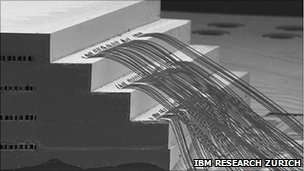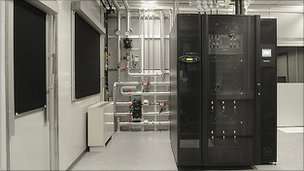November 15, 2010 weblog
Sugar cube size supercomputers

(PhysOrg.com) -- IBM labs in Zurich may very well shrink a supercomputer processor down to the size of a sugar cube making it almost 50% more energy-efficient than the world's leading supercomputers.
IBM’s approach involves stacking many computer processors on top of one another and cooling them with water flow between each layer. This method reduces computers' energy use, rather than just shrinking them.
Speaking at IBM's Zurich labs, Dr Bruno Michel told BBC News reporter; "In the past, computers were dominated by hardware costs. In the future, computers will be dominated by energy costs; to run a data center will cost more than to build it."
Dr Michel and his team have constructed a prototype to demonstrate the water-cooling principle. Called Aquasar, the supercomputer resides in a cabinet larger than a refrigerator.

Dr Michel further stated: "We currently have built this Aquasar system that's one rack full of processors. We plan that 10 to 15 years from now, we can collapse such a system in to one sugar cube; we're going to have a supercomputer in a sugar cube."
Engineers concern for future supercomputers will not be in the cost of building them but how much it will cost to operate them. The side product of any computer is heat and the cost of cooling them can get expensive.
According to Dr Michel, using current technology for a standard chip comprising a milligram of transistors and requires 1kg of equipment to cool it; this introduces a great deal of bulk.
Dr. Michel and his engineers envision stacking processors one on top of another in large stacks each separated by water cooling channels that are not much thicker than a human hair.
By stacking the processors closer together the issues of speed, size, and running costs, can be tackled all st the same time. The team has already proven the concept by building a stack of four processors, however there is much more work that still needs to be done.
More information: Via: BBC News
© 2010 PhysOrg.com


















